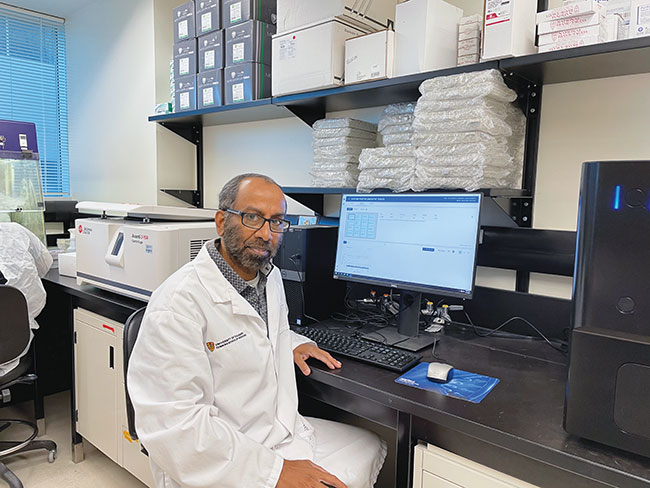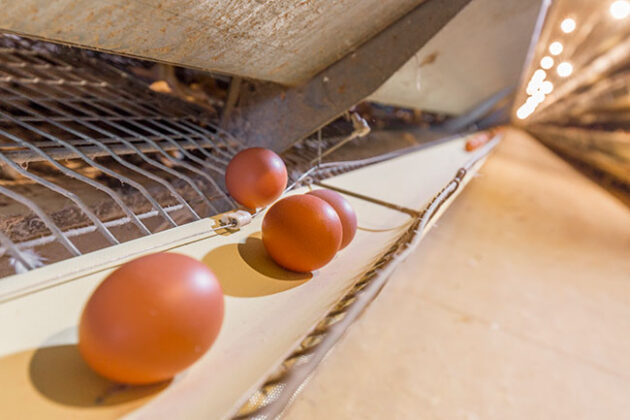
Tracking the toll of IBV
By Jane Robinson
Features Disease watchAlberta research team has made important discoveries about the extent of the damage caused by the virus, including vaccine protocols and other measures to help reduce its severity.
 Dr. Faizal Careem (middle), University of Calgary, is looking at probiotics as another IBV strategy to give birds a stronger defence against the highly contagious virus.
Photo: Dr. Faizal Careem
Dr. Faizal Careem (middle), University of Calgary, is looking at probiotics as another IBV strategy to give birds a stronger defence against the highly contagious virus.
Photo: Dr. Faizal Careem Infectious bronchitis outbreaks cost the Canadian poultry industry about $207 million every year in lost production. Losses from the highly contagious disease come mostly in laying hens because the infectious bronchitis virus (IBV) can lead to false layer syndrome, reducing egg production by as much as 40 per cent at peak of lay in infected hens. The virus also impacts broilers and breeder flocks.
Dr. Faizal Careem has been studying IBV for more than 12 years. His research team at the University of Calgary is the only group in Canada focused on reducing the impact of IBV in Canadian poultry operations via experimental studies currently involving layers.
They were the first to isolate the currently circulating IBV strains and have made important discoveries about the extent of the damage caused by the virus, including vaccine protocols and other measures to help reduce its severity.
“When we started our research on IBV, there was one dominant strain – DMV1639 – among poultry flocks in Ontario and Quebec,” says Careem, professor of virology with the faculty of veterinary medicine at the University of Calgary. “IBV is able to rapidly mutate and create new strains, similar to what we saw with the human coronavirus.”
Lower production and false layer syndrome
Before they could look at the impact of IBV, Careem and his team needed to identify the prominent strains of IBV present in Canadian flocks. They successfully identified four major strains from clinical samples originating from commercial farms in Canada – DMV1639, 4/91, Massachusetts and CA1737/04 – and were able to successfully isolate three of them in the lab for further studies. “Two of the strains we found had combined with IBV vaccine strains to generate new strains, demonstrating how the virus is able to change” says Careem.
To measure the impact of IBV on productivity and bird health, they infected the birds in peak egg production under controlled conditions with the various strains. Of the four strains, only one was not associated with egg production issues (4/91). The other three strains of IBV contributed to a 35-40 per cent decrease in egg production. And when day-old pullets were infected with DMV1639, approximately 46 per cent had cysts in oviducts that lead to false layer syndrome where hens ovulate but do not produce eggs.
These findings – when combined with economic analyses – uncovered a high benefit-cost ratio from adopting IB vaccination practices as a preventative strategy.
“Layer chicks get infected with IBV in the first two weeks of life, leading to false layer syndrome” says Careem. “And we won’t know which ones go on to develop false layer syndrome until they are in lay and producers might be seeing production levels at 60 or 70 per cent of normal.”
These findings have driven an updated vaccine protocol for layers at hatcheries to use a live attenuated IB vaccine – administered by a spray. It was an easy win and is now common practice at Ontario and Quebec hatcheries. “This hatchery protocol is helping protect layer type birds for the first weeks of life and it’s easy to administer,” says Careem.
Ideally, producers would follow up with an inactivated IB vaccine before the start of lay, but the practicality is a challenge since handling individual birds is required to administer the vaccine intramuscularly. “I think producers are reluctant to administer pre-lay vaccines for continued protection against IBV, which is understandable, and why we are continuing to look at other options that could extend immunity for the entire duration of the production cycle,” says Careem.

The researchers found IBV variants cause egg production to drop significantly.
Photo: Hendrix Genetics.
The next step in IBV research
With a much clearer understanding of the IBV variants – and proof positive that the virus causes egg production to drop significantly – Careem and his team are moving into the next phase of their IBV research. They are focusing on three key areas – exploring the value of probiotics to strength bird immunity against IBV, tweaking IB vaccination protocols and looking for novel control measures.
“IBV affects broilers as well as layers and breeder flocks, and we’re starting our probiotic trials with broilers,” explains Careem. “When broilers are infected with IBV, it can damage lining in the respiratory tract and make the birds more susceptible to secondary bacterial infections.”
They are looking at probiotics as an option to give the birds a stronger defence against disease. “We are working with broiler producers in Alberta to see if we can manipulate the microbiome with probiotics to induce immunity against IBV infection,” says Careem. The study is initially limited to broilers, but if the results are interesting, they hope to extend the work to layer pullets.
On the protocol front, Careem and his team will continue to look at ways to optimize the recommended IB vaccinations with vaccines currently available to producers in Canada. They’ll be looking at ways to better protect birds from new IBV variants that are likely to come along, ideally by inducing cross protection and looking at enhancing a bird’s immune response when vaccines are administered long before the start of lay.
“We’re also looking at the value of IB vaccination in breeder flocks that will help pass on maternal antibodies in the next generation of commercial layer flocks,” he says.
Keeping viruses out of the barn in the first place, through tight biosecurity control measures, is another key area of their research. They haven’t started that project yet, but will look at how to adjust biosecurity to minimize the introduction of IBV into barns. “I cannot emphasis enough the value of tight biosecurity measures to prevent these new IBV strains from entering commercial flocks,” says Careem.
Print this page